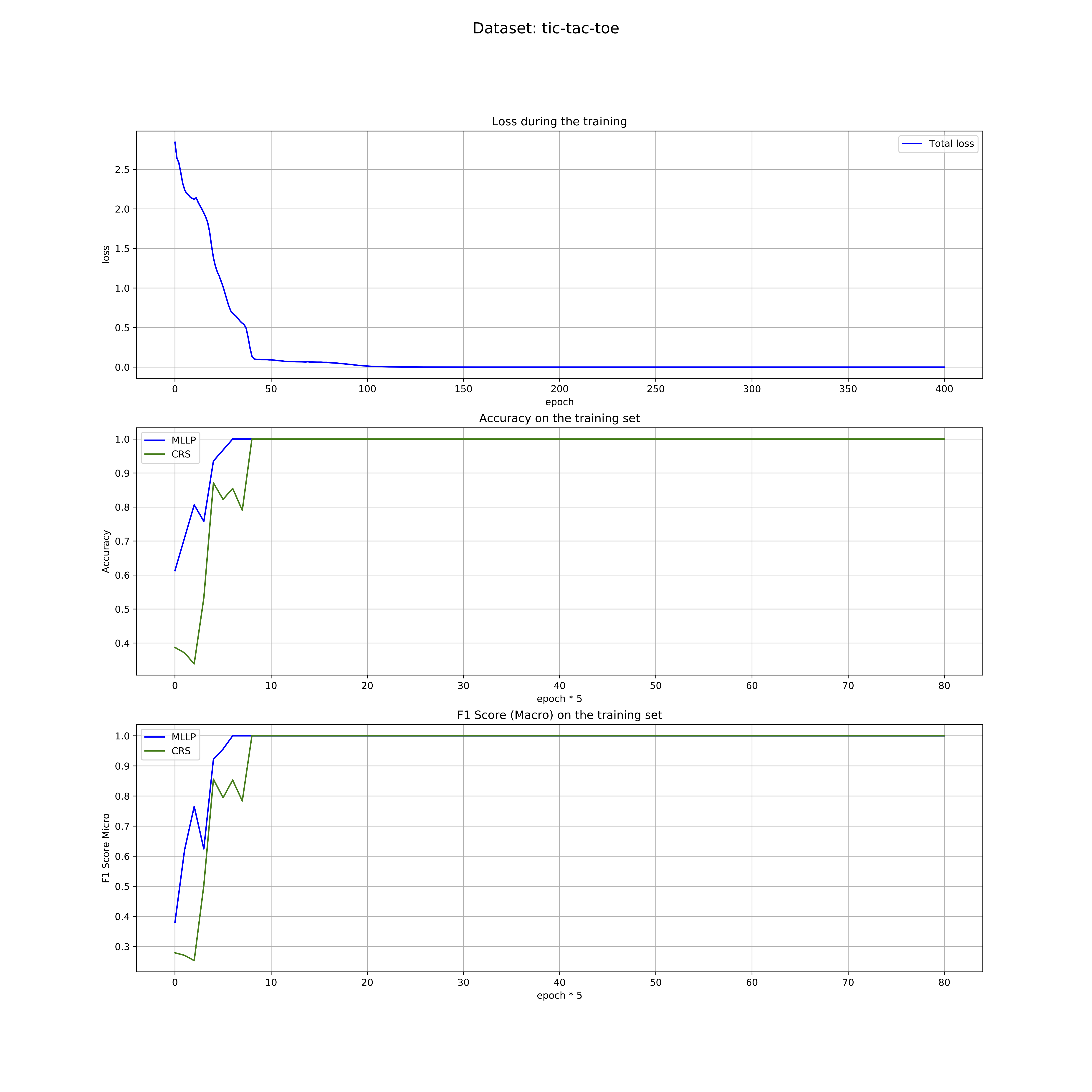For better scalability and classification performance, please refer to our new work:
- Paper: Scalable Rule-Based Representation Learning for Interpretable Classification (NeurIPS 2021).
- Code: https://github.com/12wang3/rrl
This is a PyTorch implementation of Multilayer Logical Perceptrons (MLLP) and Random Binarization (RB) method to learn Concept Rule Sets (CRS) for transparent classification tasks, as described in our paper: Transparent Classification with Multilayer Logical Perceptrons and Random Binarization.
If you want a model with a transparent inner structure (good interpretability) and high classification performance, our code may be useful for you. CRS is a hierarchical rule set model, which is transparent and interpretable. We can use gradient descent to learn the discrete CRS via continuous MLLP and the RB method efficiently.
Clone the repository and run:
python3 setup.py install- torch>=1.0.1
- torchvision>=0.2.2
- sklearn>=0.21.2
- numpy>=1.16.3
- pandas>=0.24.2
- matplotlib>=3.0.0
- CUDA (optional, for running on GPU)
We put 12 UCI data sets in the dataset folder. The description of these data sets are listed in DataSetDesc.
You can specify one data set in the dataset folder and train the model as follows:
# tic-tac-toe data set
python3 experiments.py -d tic-tac-toe &The demo will read the data set and data set information first, then discrete and binarize the data.
After data preprocessing, the demo will train the MLLP on the training set. The training log file (log.txt) can be found in the log_folder. During the training, you can check the training loss and the evaluation result on the validation set (or training set) by:
tail -f log_folder/tic-tac-toe_k5_ki0_useValidationSetFalse_e401_bs64_lr0.01_lrdr0.75_lrde100_wd0.0_p0.0_useNOTFalse_L64/log.txtAfter training, the evaluation result on the test set is shown at the end of log.txt:
[INFO] - ============================================================
[INFO] - Test:
Accuracy of MLLP Model: 0.9895833333333334
Accuracy of CRS Model: 1.0
[INFO] - Test:
F1 Score of MLLP Model: 0.989158667419537
F1 Score of CRS Model: 1.0
[INFO] - ============================================================
The figure of training loss is shown in plot_file.pdf.

Moreover, the trained MLLP model is save in model.pth, and the extracted CRS is printed in crs.txt:
class_negative:
r1,6: [' 2_o', ' 5_o', ' 8_o']
r1,16: [' 7_o', ' 8_o', ' 9_o']
r1,20: [' 1_o', ' 5_o', ' 9_o']
r1,24: [' 1_x', ' 2_o', ' 3_x', ' 6_x', ' 7_o', ' 9_o']
r1,27: [' 1_o', ' 4_o', ' 7_o']
r1,39: [' 3_x', ' 4_x', ' 6_o', ' 7_o', ' 8_x', ' 9_x']
r1,40: [' 2_x', ' 3_o', ' 5_o', ' 6_x', ' 8_o', ' 9_x']
r1,48: [' 4_o', ' 5_o', ' 6_o']
r1,50: [' 3_o', ' 6_o', ' 9_o']
r1,55: [' 1_x', ' 4_o', ' 6_x', ' 7_x', ' 8_x', ' 9_o']
r1,58: [' 1_o', ' 2_x', ' 4_x', ' 6_o', ' 8_o', ' 9_x']
r1,60: [' 3_o', ' 5_o', ' 7_o']
r1,62: [' 1_o', ' 2_o', ' 3_o']
class_positive:
r1,3: [' 3_x', ' 5_x', ' 7_x']
r1,5: [' 2_x', ' 5_x', ' 8_x']
r1,26: [' 1_x', ' 2_x', ' 3_x']
r1,29: [' 7_x', ' 8_x', ' 9_x']
r1,37: [' 3_x', ' 6_x', ' 9_x']
r1,38: [' 4_x', ' 5_x', ' 6_x']
r1,51: [' 1_x', ' 4_x', ' 7_x']
r1,52: [' 1_x', ' 5_x', ' 9_x']
The 2_o denotes the second square is o. The r1,6: [' 2_o', ' 5_o', ' 8_o'] denotes the rule  .
.
The rule set  and
and  are used for label prediction.
are used for label prediction.
Try another data set with more specified arguments:
# adult data set
# You'd better run it on GPU for training large network on CPU may cost lots of time.
python3 experiments.py -d adult -e 800 -bs 64 -lr 0.005 -p 0.9 --use_not --use_validation_set -s 256_256_64 &If GPU is available, the demo will run on GPU automatically.
You can use the demo to train MLLP and CRS on your own data set by putting the data and data information files in the dataset folder. Please read DataSetDesc for a more specific guideline.
List all the available arguments and their default values by:
$ python3 experiments.py --help
usage: experiments.py [-h] [-d DATA_SET] [-k KFOLD] [-ki ITH_KFOLD]
[--use_validation_set] [-e EPOCH] [-bs BATCH_SIZE]
[-lr LEARNING_RATE] [-lrdr LR_DECAY_RATE]
[-lrde LR_DECAY_EPOCH] [-wd WEIGHT_DECAY]
[-p RANDOM_BINARIZATION_RATE] [--use_not] [-s STRUCTURE]
optional arguments:
-h, --help show this help message and exit
-d DATA_SET, --data_set DATA_SET
Set the data set for training. All the data sets in
the dataset folder are available. (default: tic-tac-
toe)
-k KFOLD, --kfold KFOLD
Set the k of K-Folds cross-validation. (default: 5)
-ki ITH_KFOLD, --ith_kfold ITH_KFOLD
Do the i-th validation, 0 <= ki < k. (default: 0)
--use_validation_set Use the validation set for parameters tuning.
(default: False)
-e EPOCH, --epoch EPOCH
Set the total epoch. (default: 401)
-bs BATCH_SIZE, --batch_size BATCH_SIZE
Set the batch size. (default: 64)
-lr LEARNING_RATE, --learning_rate LEARNING_RATE
Set the initial learning rate. (default: 0.01)
-lrdr LR_DECAY_RATE, --lr_decay_rate LR_DECAY_RATE
Set the learning rate decay rate. (default: 0.75)
-lrde LR_DECAY_EPOCH, --lr_decay_epoch LR_DECAY_EPOCH
Set the learning rate decay epoch. (default: 100)
-wd WEIGHT_DECAY, --weight_decay WEIGHT_DECAY
Set the weight decay (L2 penalty). (default: 0.0)
-p RANDOM_BINARIZATION_RATE, --random_binarization_rate RANDOM_BINARIZATION_RATE
Set the rate of random binarization. It is important
for CRS extractions from deep MLLPs. (default: 0.0)
--use_not Use the NOT (~) operator in logical rules. It will
enhance model capability but make the CRS more
complex. (default: False)
-s STRUCTURE, --structure STRUCTURE
Set the structure of network. Only the number of nodes
in middle layers are needed. E.g., 64, 64_32_16. The
total number of middle layers should be odd. (default: 64)
You can use the mllp package in your code easily after installation.
The tutorial is shown in the jupyter notebook tutorial.ipynb.
If our work is helpful to you, please kindly cite our paper as:
@inproceedings{wang2020transparent,
title={Transparent classification with multilayer logical perceptrons and random binarization},
author={Wang, Zhuo and Zhang, Wei and Ning, LIU and Wang, Jianyong},
booktitle={Proceedings of the AAAI conference on artificial intelligence},
volume={34},
number={04},
pages={6331--6339},
year={2020}
}
